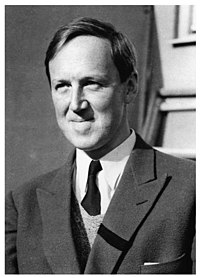Hannes Alfvén
| Hannes Alfvén | |
|---|---|
 |
|
| Born | Hannes Olof Gösta Alfvén 30 May 1908 Norrköping, Sweden |
| Died | 2 April 1995 (aged 86) Djursholm, Sweden |
| Fields | Electrical engineering and Plasma physics |
| Institutions | |
| Alma mater | University of Uppsala |
| Doctoral advisor |
Manne Siegbahn Carl Wilhelm Oseen |
| Doctoral students |
|
| Known for | |
| Notable awards |
|
Hannes Olof Gösta Alfvén (Swedish: [alˈveːn]; 30 May 1908 – 2 April 1995) was a Swedish electrical engineer, plasma physicist and winner of the 1970 Nobel Prize in Physics for his work on magnetohydrodynamics (MHD). He described the class of MHD waves now known as Alfvén waves. He was originally trained as an electrical power engineer and later moved to research and teaching in the fields of plasma physics and electrical engineering. Alfvén made many contributions to plasma physics, including theories describing the behavior of aurorae, the Van Allen radiation belts, the effect of magnetic storms on the Earth's magnetic field, the terrestrial magnetosphere, and the dynamics of plasmas in the Milky Way galaxy.
Alfvén received his PhD from the University of Uppsala in 1934. His thesis was titled "Investigations of the Ultra-short Electromagnetic Waves."
In 1934, Alfvén taught physics at both the University of Uppsala and the Nobel Institute for Physics (later renamed the Manne Siegbahn Institute of Physics) in , Sweden. In 1940, he became professor of electromagnetic theory and electrical measurements at the Royal Institute of Technology in Stockholm. In 1945, he acquired the nonappointive position of Chair of Electronics. His title was changed to Chair of Plasma Physics in 1963. From 1954 to 1955, Alfvén was a Fulbright Scholar at the University of Maryland, College Park. In 1967, after leaving Sweden and spending time in the Soviet Union, he moved to the United States. Alfvén worked in the departments of electrical engineering at both the University of California, San Diego and the University of Southern California.
...
Wikipedia
